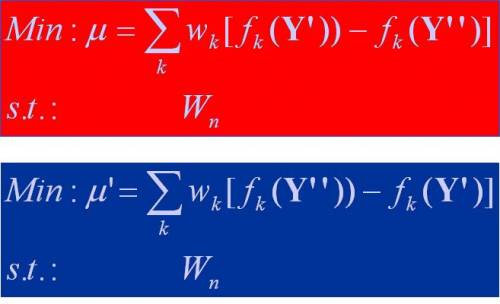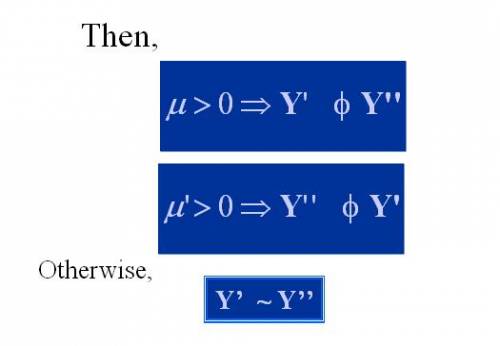| Section categories |
|
Related Subjects [38]
This category includes brief overview of all related subjects.
|
|
Defining BioInformatics [7]
In this section we tried to briefly explain what bioinformatics is ?
|
|
Unviersities [30]
This contains information about universities that are offering bioinformatics degree programs.
|
|
Resources [24]
Contains information about bioinformatics resources including databases, tools and techniques.
|
|
Algorithms [31]
This category includes some of the basic algorithms that are usually used by bioinformaticians.
|
|
| Statistics |
Total online: 1 Guests: 1 Users: 0 |
|
Home » 2011 » August » 22 » Genetic Algorithms 2
11:22 PM Genetic Algorithms 2 |
Genetic Algorithms
6. Parent/Survivor Selection: - Strategies
- Always keep the best one
- Elitist: deletion of the K worst
- Probability selection : inverse to their fitness
- Etc.
- Too strong fitness selection bias can lead to sub-optimal solution
- Too little fitness bias selection results in unfocused and meandering search
- Parent selection
- Chance to be selected as parent proportional to fitness
- To avoid problems with fitness function
- Not a very important parameter
- Uniform randomly selection
- Probability selection : proportional to their fitness
- Tournament selection (Multiple Objectives)
- Build a small comparison set Randomly select a pair with the higher rank one beats the lower one Non-dominated one beat the dominated one Niche count: the number of points in the population within� certain distance, higher the niche count, lower the rank.
- Etc.
- Others
- Global Optimal
- Parameter Tuning
- Parallelism
- Random number generators
7. Example Of Coding For TSP: - Binary
- Cities are binary coded; chromosome is string of bits
- Most chromosomes code for illegal tour
- Several chromosomes code for the same tour
- Path
- Cities are numbered; chromosome is string of integers
- Most chromosomes code for illegal tour
- Several chromosomes code for the same tour
- Ordinal
- Cities are numbered, but code is complex
- All possible chromosomes are legal and only one chromosome for each tour
- Several others
8. Roulette wheel: - Sum the fitness of all chromosomes, call it T
- Generate a random number N between 1 and T
- Return chromosome whose fitness added to the running total is equal to or larger than N
- Chance to be selected is exactly proportional to fitness
Chromosome : 1 2 3 4 5 6 Fitness : 8 2 17 7 4 11 Running total : 8 10 27 34 38 49 N (1 £ N £ 49): 23 Selected : 3
9. Tournament:
- Binary tournament
- Two individuals are randomly chosen; the fitter of the two is selected as a parent
- Probabilistic binary tournament
- Two individuals are randomly chosen; with a chance p, 0.5<p<1, the fitter of the two is selected as a parent
- Larger tournaments
- n individuals are randomly chosen; the fittest one is selected as a parent
- By changing n and/or p, the GA can be adjusted dynamically
10. Problems With Fitness Range: - Premature Convergence
- DFitness too large
- Relatively superfit individuals dominate population
- Population converges to a local maximum
- Too much exploitation; too few exploration
- Slow Finishing
- DFitness too small
- No selection pressure
- After many generations, average fitness has converged, but no global maximum is found; not sufficient difference between best and average fitness
- Too few exploitation; too much exploration
11. Solutions For These Problems: - Use tournament selection
- Implicit fitness remapping
- Adjust fitness function for roulette wheel
- Explicit fitness remapping
- Fitness scaling
- Fitness windowing
- Fitness ranking
12. Fitness Function: - Purpose
- Parent selection
- Measure for convergence
- For Steady state: Selection of individuals to die
- Should reflect the value of the chromosome in some "real” way
- Next to coding the most critical part of a GA
- Fitness scaling
- Fitness values are scaled by subtraction and division so that worst value is close to 0 and the best value is close to a certain value, typically 2
- Chance for the most fit individual is 2 times the average
- Chance for the least fit individual is close to 0
- Problems when the original maximum is very extreme (super-fit) or when the original minimum is very extreme (super-unfit)
- Can be solved by defining a minimum and/or a maximum value for the fitness
- Example of Fitness Scaling
- Fitness windowing
- Same as window scaling, except the amount subtracted is the minimum observed in the n previous generations, with n e.g. 10
- Same problems as with scaling
- Fitness Ranking
- Individuals are numbered in order of increasing fitness
- The rank in this order is the adjusted fitness
- Starting number and increment can be chosen in several ways and influence the results
- No problems with super-fit or super-unfit
- Often superior to scaling and windowing
- Fitness Evaluation
- A key component in GA
- Time/quality trade off
- Multi-criterion fitness
- Multi-Criterion Fitness
- Dominance and Indifference
- For an optimization problem with more than one objective function (fi, i=1,2,…n)
- given any two solution X1 and X2, then
- X1 dominates X2 ( X1 X2), if
fi(X1) >= fi(X2), for all i = 1,…,n
- X1 is indifferent with X2 ( X1 ~ X2), if X1 does not dominate X2, and X2 does not dominate X1
- Pareto Optimal Set
- If there exists no solution in the search space which dominates any member in the set P, then the solutions belonging the the set P constitute a global Pareto-optimal set.
- Pareto optimal front
- Dominance Check
- Weighted sum
- F(x) = w1f1(x1) + w2f2(x2) +…+wnfn(xn)
- Problems?
- Convex and convex Pareto optimal frontSensitive to the shape of the Pareto-optimal front
- Selection of weights?
- Need some pre-knowledge
- Not reliable for problem involving uncertainties
- Optimizing single objective
- Maximize: fk(X) Subject to: fj(X) <= Ki ,i <> k , X in F where F is the solution space.
- Preference based weighted sum
- �(ISMAUT Imprecisely Specific Multiple Attribute Utility Theory)
- F(x) = w1f1(x1) + w2f2(x2) +…+wnfn(xn)
- Preference
- Given two know individuals X and Y, if we prefer X than Y, then� F(X) > F(Y), �that is� w1(f1(x1)-f1(y1)) +…+wn(fn(xn)-fn(yn)) > 0
- All the preferences constitute a linear space Wn={w1,w2,…,wn}
- w1(f1(x1)-f1(y1)) +…+wn(fn(xn)-fn(yn)) > 0
- w1(f1(z1)-f1(p1)) +…+wn(fn(zn)-fn(pn)) > 0, etc
- For any two new individuals Y’ and Y’’, how to determine which one is more preferable?
 
Construct the dominant relationship among some indifferent ones according to the preferences.
|
|
|
Category: Algorithms |
Views: 1456 |
Added by: Ansari
| Rating: 0.0/0 |
|
|
|




